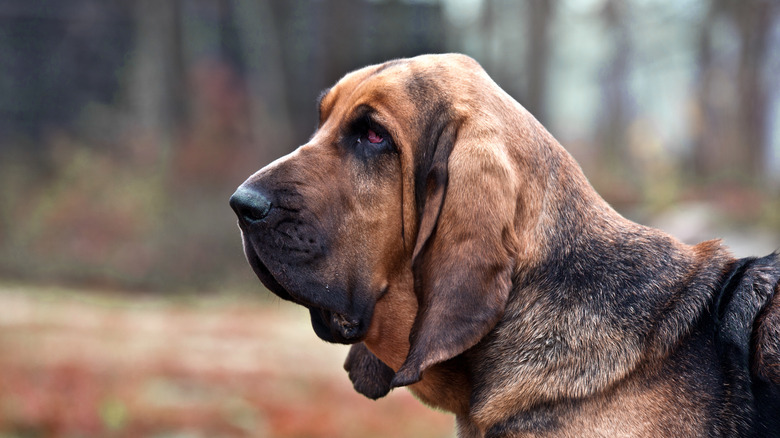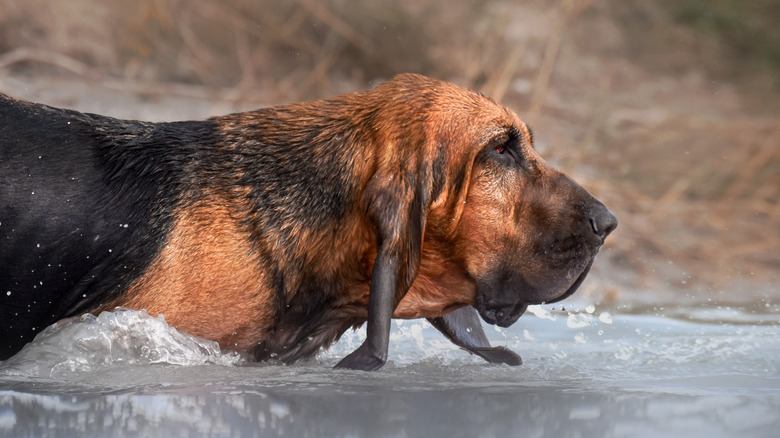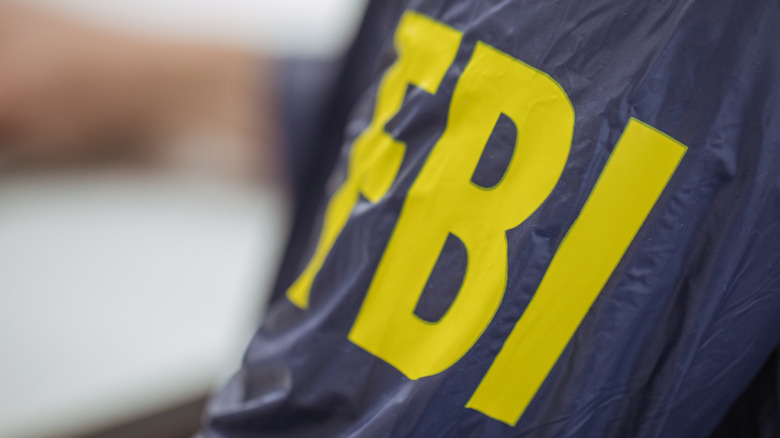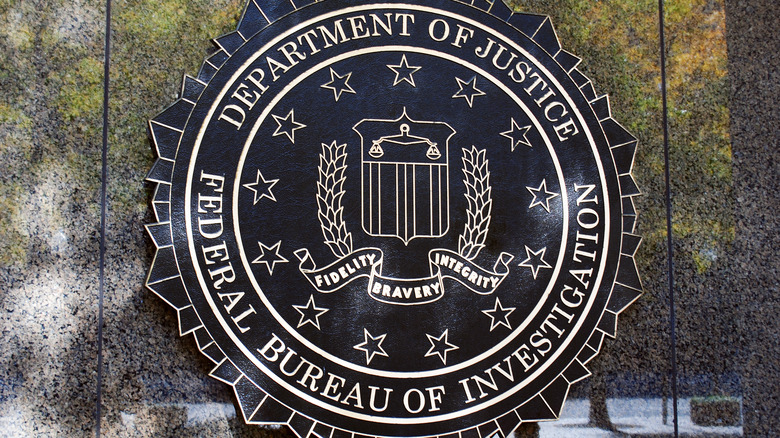The Truth Behind The FBI's Magic Bloodhounds
Dr. Steven J. Hatfill became a person of interest in the FBI investigation into the 2001 mailing of anthrax-laced letters that killed five people and sickened 17, the worst bio-terror of its kind in U.S. history, per the FBI website. What drew the FBI's attention to the physician was how the federal law enforcement agency's team of so-called "magic bloodhounds" responded once inside his apartment. Though K-9 units in law enforcement are common, the manner in which law enforcement uses bloodhounds to identify suspects can sometimes be controversial, as it was with Hatfill and the anthrax case.
Controversy aside, the FBI was investigating Hatfill in regards to the anthrax attack for a number of other reasons beyond just how the bloodhounds responded: He formerly worked at an army lab where the strain of anthrax used at the attack was stored; his handwriting was similar to that found on the envelopes containing the bacteria; and he had written and published a novel in which a similar attack to that of the anthrax-laced letters was carried out, per CBS News. As The New York Times notes, Hatfill was exonerated partially due to the bloodhounds' inability to accurately identify suspects based on scent.
Humans have long used bloodhounds for their keen sense of smell
Humans and bloodhounds — descended from 7th century French St. Hubert hounds — have a history of working together both for hunting and tracking (via Missing Animal Response). Bred to be hardworking and team-oriented, their incredible sense of smell makes this canine breed very useful for such tasks. With more scent receptors than any other dog breed (over 300 million), bloodhounds possess an uncommon ability to pick out a scent — sometimes just through the air. So much so that bloodhound "testimony" is even admissible in certain courts of law, according to Sit Means Sit.
What's also notable is that bloodhound units — such as the one the New York Police Department is known to use — perform a very different function than patrol dogs. While patrol dogs also often have the strong ability to detect scent, they're most often used to apprehend a suspect that a bloodhound has helped identify. Given the track record of bloodhounds in solving crime, several significant law enforcement associations of bloodhound handlers exist, like the Law Enforcement Bloodhound Association and the National Police Bloodhound Association, per The Baltimore Sun.
Lucy, Knight, and TinkerBelle were on the case
Bloodhounds are commonly used in law enforcement, but what cast suspicion on how the FBI's team of "magic bloodhounds" responded inside Steven Hatfill's apartment was less the presence of the dogs themselves and more the nature of the scent they were tracking, where the dog's came from, and who their handlers were (via The Baltimore Sun). To aid in the investigation, three bloodhounds named Lucy, Knight, and TinkerBelle were flown across the country from Southern California to Frederick, Maryland. At that time, the FBI had no bloodhound unit of their own, so bloodhound handlers were called in from outside the agency.
Based on their credentials, as well as their unusual approach to handling bloodhounds, the handlers were not well-respected inside the bloodhound law enforcement community. Strong evidence suggests that bloodhounds can reliably identify, track, and find humans based on scents gathered from articles of clothing and other items in a process called scent transfer, according to the U.S. Department of Justice Office of Justice Programs. Less well known, though, is how well the dogs can match firearms with spent shell casings or, in the case of Hatfill, a person to decontaminated envelopes based on smell alone.
Bloodhound evidence is not foolproof
How and what a bloodhound tracks, as well as what the animal might uncover, is known to be unreliable. They are, after all, only animals, and bloodhound response alone is not enough for conviction. For every time a bloodhound successfully tracks or identifies a suspect, there are known false positives in which suspects turn out to be innocent (via CBS News). For example, Lucy, Knight, and TinkerBelle, the three dogs used to investigate Hatfill, were also used in the so-called "Beltway sniper" case (via FBI). In that instance, the dogs attempted to track a suspect based on spent shell casings, leading to two dead ends in the investigation.
After gathering scent from three different envelopes, the so-called "magic bloodhounds" were brought in by the FBI to search Steven Hatfill's apartment, and one dog simply came near the physician — behavior that was perceived by the handlers to be an identification. The same dogs had also ignored other suspects. Also contentious among bloodhound experts was the question of whether an accurate scent could even be gathered from an anthrax-contaminated letter sent through the mail, touched by many different people and intermingled with other objects, and then decontaminated with radiation. According to bloodhound expert Corporal Douglas H. Lowrey from the Maryland State Police, in the instance of the anthrax attack, there were just too many variables for bloodhounds to be used at all.
Hatfill sued the FBI
After Steven Hatfill was identified by the FBI in the press as a leading suspect and person of interest in the anthrax case based largely on the behavior of the magic bloodhounds as well as other forms of circumstantial evidence, Hatfill maintained his innocence. He would go on to sue the federal agency for wrongfully implicating him in the crime and tarnishing his reputation. According to CBS News. Hatfill said, "I object to an investigation characterized, as this one has been, by outrageous official statements, calculated leaks to the media, and causing a feeding frenzy operating to my great prejudice."
In 2008, Hatifill's suit against the FBI and the Department of Justice was settled for $4.6 million, as The New York Times reports. Speaking with the Times, Hatfill's lawyer, Mark Grannis, said, "The good news is that we still live in a country where a guy who's been horribly abused can go to a judge and say 'I need your help,' and maybe it takes a while, but he gets justice." Grannis added that his client was no longer a person of interest in the anthrax attack investigation. At that time, the anthrax attack investigation remained open despite a massive effort on the part of investigators, drawing sharp criticism from legislators and the media.
The anthrax case is now closed
Around the same point that Steven Hatfill was cleared of suspicion, another U.S. Army scientist and person of interest, Bruce Ivins, committed suicide before charges could be brought against him. Though evidence linked Ivins to the specific strain of anthrax used in the attack, the guilty verdict drawn by federal investigators remains disputed, based on 2011 reporting from ProPublica. Despite the outcome of the Hatfill case — which involved evidence gathered by bloodhounds — as of 2010, bloodhounds, including Tinkerbelle and Lucy, remained an important tool in FBI investigation.
Founded in 2002, shortly after the anthrax attacks took place, bloodhounds are now used as part of the Human Scent Evidence Team (HSET) to track suspects, sniff-out explosives, and recover human remains, among other tasks (via the FBI). Per the agency's website in 2010, an FBI representative said of using bloodhounds, "Our goal is to promote a science-driven program with the highest standards of training, certification, and professionalism ... It's part of the FBI Laboratory's commitment to provide exceptional forensic science services to our federal, state, local, and international law enforcement partners." The complete story of the anthrax attacks is told in the Netflix documentary "The Anthrax Attacks: In the Shadow of 9/11."





